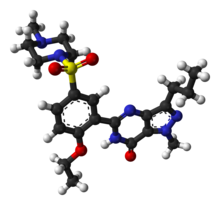 |
| Structure of Sildenafil citrate |
 |
| The Blue Pill |
Although Viagra was introduced as a prescription drug, Pfizer made every effort to market it to every household they could, not only in the United States but also worldwide.
The marketing of the drug was done so well that within a couple of years of its release, Viagra accounted for 92% of the global prescriptions for erectile dysfunction and even though its market share has dropped is helping Pfizer make millions every year. Since PDE-5 is also seen on the arterial walls of the lungs, Pfizer also sells another preparation of Sildenafil, called Revatio, for treatment of rare condition called pulmonary arterial hypertension or PAH. Both medications, Viagra and Revatio, are evidence that Pfizer put the information they got out of their initial failures to good use and leave a lot to be learnt from this story.


